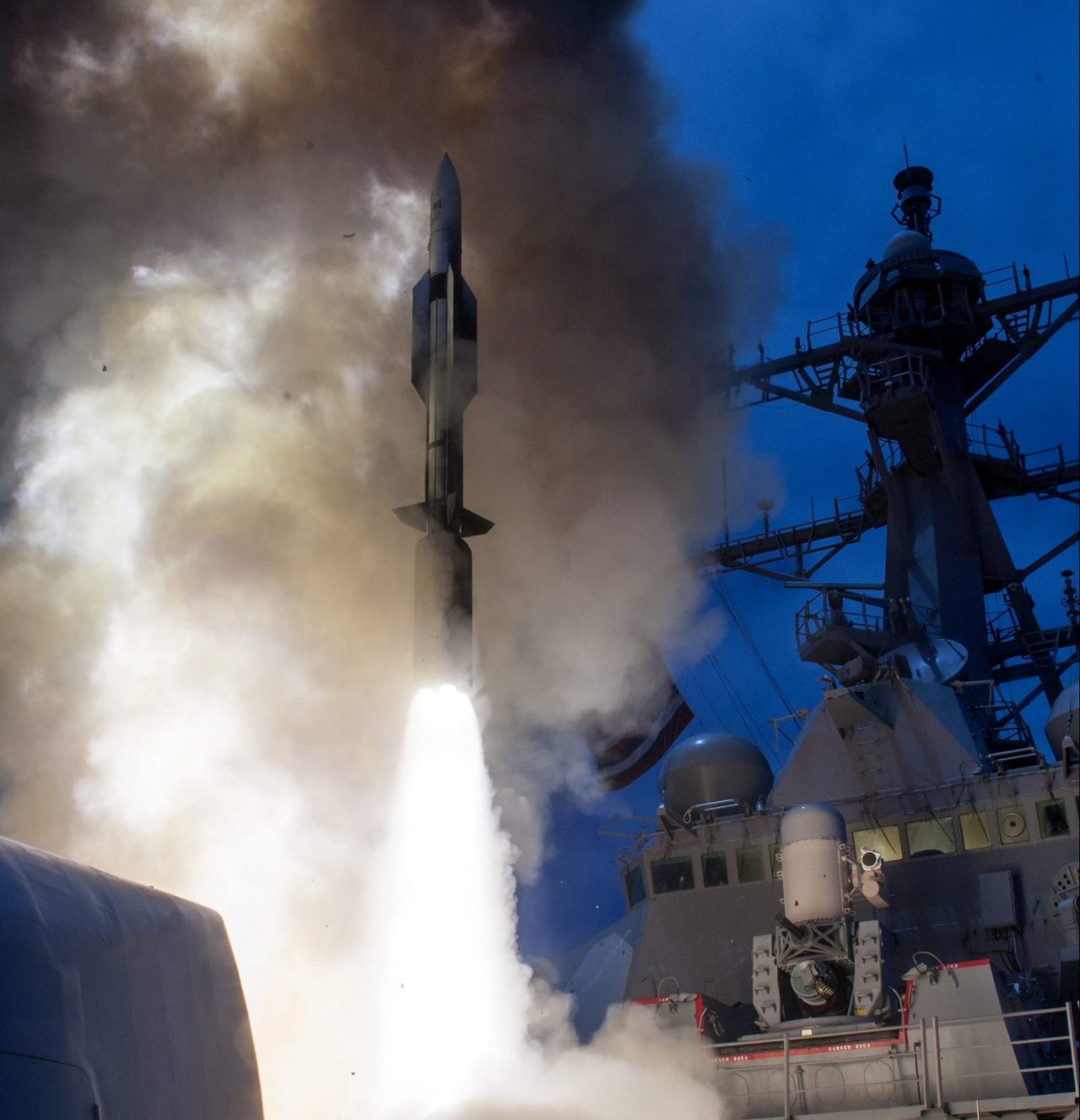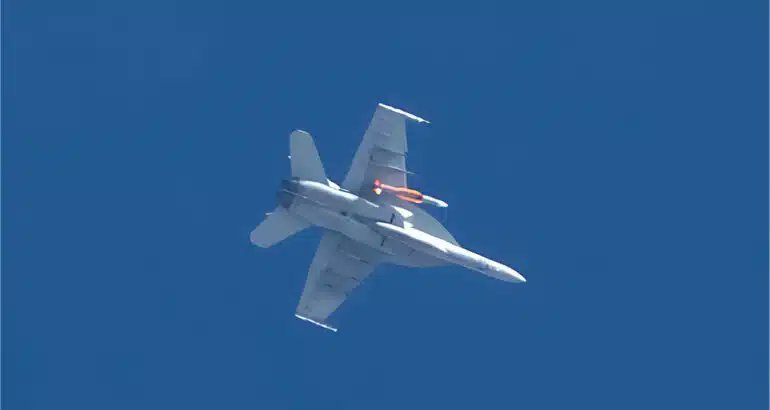The US SM-6 missiles are hogging the headlines again after photographs of a US Navy F/A-18 Super Hornet appeared carrying what looked like an air-launched variant of the SM-6, or the RIM-174 missile.
The photographed munition is believed to be an inert Standard Missile 6 (SM-6) surface-to-air missile. The photos, accessed by several media portals, have garnered special attention from observers because an SM-6 missile on a Super Hornet is an unusual occurrence.
The last time a Super Hornet was seen with an SM-6 missile was in 2021 when a civilian photographer shot a picture, which Aerospace DAILY later obtained. The photo depicted a Boeing F/A-18F Super Hornet with an SM-6 under its left pylon, but the service never officially acknowledged it.
As the recent photo started receiving attention, several experts noted that it was plausible that the Super Hornet could be a launching pad for an SM-6 to test some of its newer capabilities against a hostile target. There has been no official word from the US Navy regarding the development. All claims, for now, are mere conjectures and speculations.
Over the years, several discussions have taken place about combining the Super Hornets with SM-6 missiles to bolster the US Navy’s capabilities. For instance, some suggestions from 2018 included converting the SM-6 Dual I SAM into a long-range air-to-air missile and integrating it into the Super Hornet.
AfriPrime App link: FREE to download...
https://www.amazon.com/Africircle-AfriPrime/dp/B0D2M3F2JT
The missile’s integration into combat jets would bolster the US Navy’s combat capability because when these missiles are fired at a high altitude and a fast speed, they could not only destroy enemy aircraft hundreds of miles away but also destroy ships and even oncoming ballistic missiles at a similar distance. This is believed to be a promising capability in a conflict with adversaries like China.
Currently, while being equipped with some of the most cutting-edge munitions in the US arsenal, the Super Hornets, which are capable of taking off from US aircraft carriers, do not have anything like the SM-6, which can strike targets both on land and at sea and over long distances at near-hypersonic speeds.
The SM-6 was initially intended to be a surface-launched weapon that could attack air-breathing airborne threats at long range, ballistic missiles nearing the end of their flight, and, in certain situations, even hypersonic weapons. However, it has since been modified and adapted by all services.
The SM-6 is used by US Navy ships for air defense. Introduced into the Aegis Combat System, the weapon’s primary purpose was long-range anti-aircraft combat. However, the missile can also be a quasi-ballistic missile to attack warships and other high-priority ground targets, like air defense installations. It has also been embraced by the US Army for use in land attack roles as a ground-launched weapon.
Raytheon describes the missile: “The SM-6 missile is three missiles in one. It’s the only weapon that can perform anti-air warfare, anti-surface warfare, and ballistic missile defense or sea-based terminal missions.” Analysts reckon the SM-6 missile has developed into a multi-role powerhouse. It is also a perfect example of how adding new technology to outdated weapons can produce amazing outcomes.
The missile’s almost unmatchable capabilities—and its several upgraded variants—have ensured its presence in the limelight. In the last few weeks, several developments worldwide, especially in China’s backyard, have featured the SM-6 missile in some form.
The SM-6 Is Trending And How!
The biggest news about the SM-6 came earlier this year when the Pentagon officially acknowledged, for the first time, that the US Navy used the SM-6 missile against Yemen-based Houthi militants who had been relentlessly launching missile and drone attacks on Western ships.
At the time, an unnamed US defense official said that an SM-6 was successfully fired at a Houthi anti-ship ballistic missile (ASBM) in the Gulf of Aden. The missile was fired by the USS Carney (DDG-64), a destroyer of the Arleigh Burke class. Since then, the active use of the missile in the Red Sea has become common knowledge.
Another interesting development involving the SM-6 was when the US Army sent its ground-based missile system ‘Typhon’ to participate in the ‘Balikatan 2024 military drills in the Philippines. This was the first overseas deployment of this cutting-edge system. This was significant because the Typhon system could launch various missiles, including the new SM-6 interceptor missile.
The SM-6 installed on Typhon is used mainly as a short-range ballistic missile against land and sea targets. The Army considers it a “strategic” weapon system that would be employed against more valuable targets such as command and control centers and air defense installations.
AfriPrime App link: FREE to download...
https://www.amazon.com/Africircle-AfriPrime/dp/B0D2M3F2JT

Not surprisingly, the deployment in the Philippines rattled China, and its Defense Ministry Spokesperson Wu Qian warned at a press briefing on April 25 that the US deployment of an intermediate missile system in the Asia-Pacific could prompt Beijing to respond with decisive measures.
“We resolutely oppose the US move to deploy intermediate-range ballistic missiles in the Asia-Pacific. Our position has been clear and consistent. US steps are posing a major threat to the security and stability of regional players and will inevitably prompt a decisive response from China,” he warned.
During exercises, the US also deployed the SM-6 variant of the Typhon MRC in September 2023 on the Danish island of Bornholm in the Baltic Sea. Moscow then argued that the US had long wanted to introduce the system and was only waiting for the collapse of the Intermediate-Range Nuclear Forces (INF) Treaty, which prohibited the fielding of the system.
The SM-6’s sheer precision and advanced capability were on display when it intercepted a medium-range ballistic missile target in a test conducted at sea in late March this year. The recent test with the USS Preble (DDG 88) marked a significant milestone in advancing the SM-6 system.
The SM-6 Dual II (Block IA) configuration, using the Baseline 9.C2 version of the Aegis Combat System and newly qualified software, proved that it could neutralize incoming threats even in the last moments of flight.
With the successful intercept, the SM-6 completed seven flight tests against ballistic missile targets, including four with the Dual II (Block IA) configuration. The SM-6 enhances the offensive and defensive capabilities of surface vessels and has proven its effectiveness in anti-air, anti-surface, and sea-based terminal ballistic missile defense.
Its capabilities have rattled US adversaries and aroused the interest of US allies like Japan. In 2022, the State Department approved a potential $450 million Foreign Military Sale (FMS) of 32 Standard Missile 6 (SM-6) Block I missiles and related equipment.
Last year, the US State Department approved a possible Foreign Military Sale of 38 Standard Missile-6 Block I (SM-6) units to the South Korean Government.
AfriPrime App link: FREE to download...
https://www.amazon.com/Africircle-AfriPrime/dp/B0D2M3F2JT
As the next-generation US missiles like AIM-260 are still in development and hypersonic missiles at least months away, the SM-6 has emerged as the most popular weapon in the US inventory.



